What is Tamago Kake Gohan?
Tamago kake gohan is a dish or way of eating rice with a raw egg drizzled with a condiment such as soy sauce or mentsuyu (a dashi-based sauce). It can also feature various toppings to suit your tastes.
It’s typically eaten for breakfast but can also be enjoyed for lunch or brunch. These days, some call it ‘TKG,’ an acronym for its Romanized form.
Well, it’s just hot rice and raw egg…is there any history to it? Indeed, there is! Tamago kake gohan was originally created by a journalist named Kishida Ginko in the 19th century. Eggs began to be eaten in Japan in the Edo period (1603-1867), but at this time, they were still an expensive food, and it was not until the modern era (late 19th century) that eggs became a common household item.
It is believed that he encouraged people around the area to make the tamago kake gohan he invented. According to a magazine published in 1927, the seasoning was grilled salt and chili pepper! It’s completely different from what it is now!
After the 1950s, when eggs became a common item again, the dish attracted attention for its taste and nutritional qualities and became one of the favorites on the breakfast table.

How I Developed This Recipe
Tamago Kake Gohan was a staple in my diet growing up. It was simple, cheap, and versatile, and it really satisfied me. Alongside natto, it became a regular part of my breakfast and lunch routine.
So, I wanted to share all the different ways I’ve used TKG over the years in this article.
To give you some variety and ideas, I’ve included 15 different topping ideas for Tamago Kake Gohan. I hope these ideas will help you find your own favorite ways to enjoy TKG!
How to Make TKG Like A Pro
I know I said there are a lot of twists of tamago kake gohan, but before explaining these, I will explain the most basic and standard way to make Tamago kake gohan in Japan.
This is what Japan Tamago kake Gohan Research Institute, Inc. (2021) calls “sunrise.” I will heavily base the steps on their method to honor this research institute.
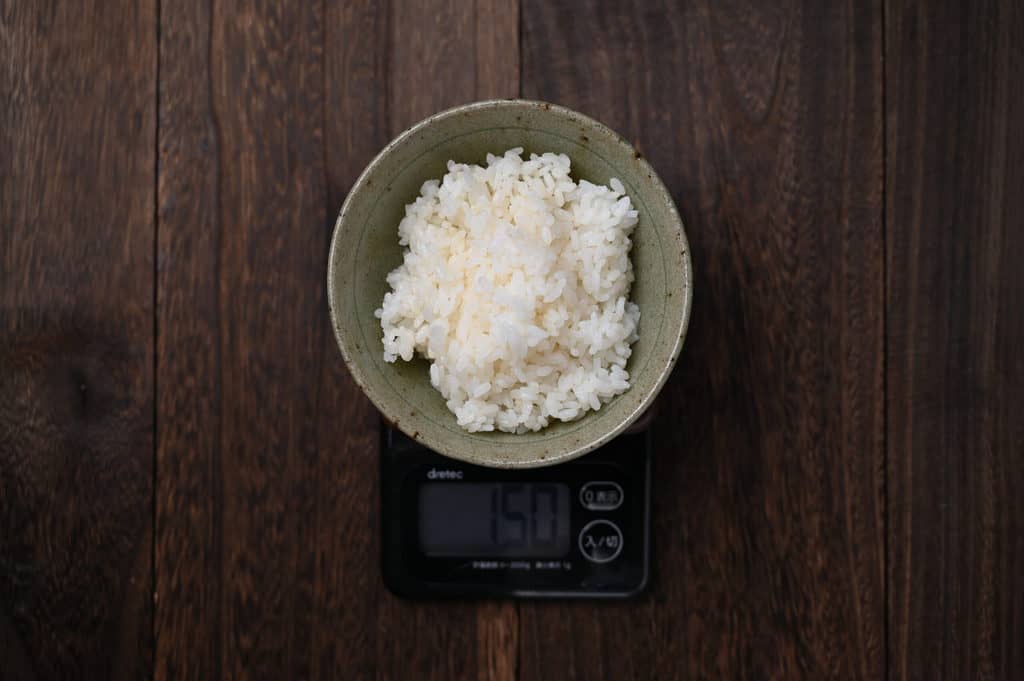
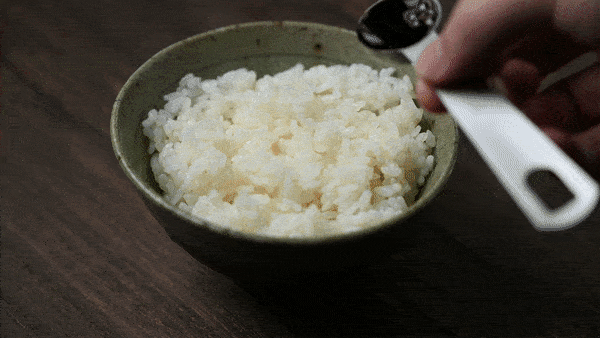
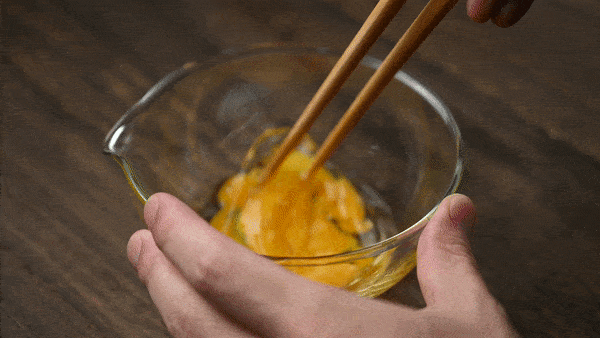
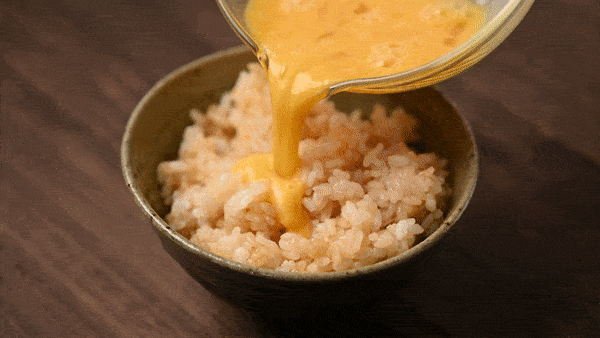
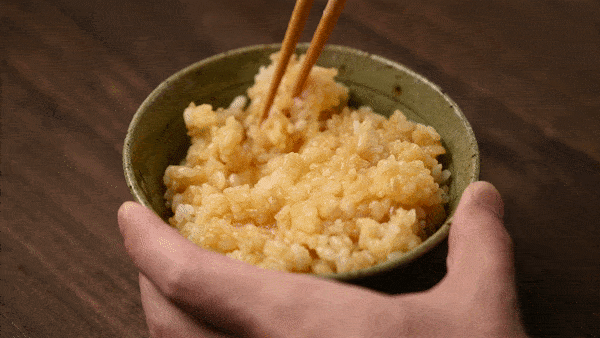
15 Topping/Variation Ideas
As you know, this dish is basically just raw egg and rice. Although it’s still good as it is, people put extra toppings to suit their own taste. I’m no exception, and I have tried many different toppings throughout my life.
So, I will list all the toppings I have liked here for more inspiration!
Natto
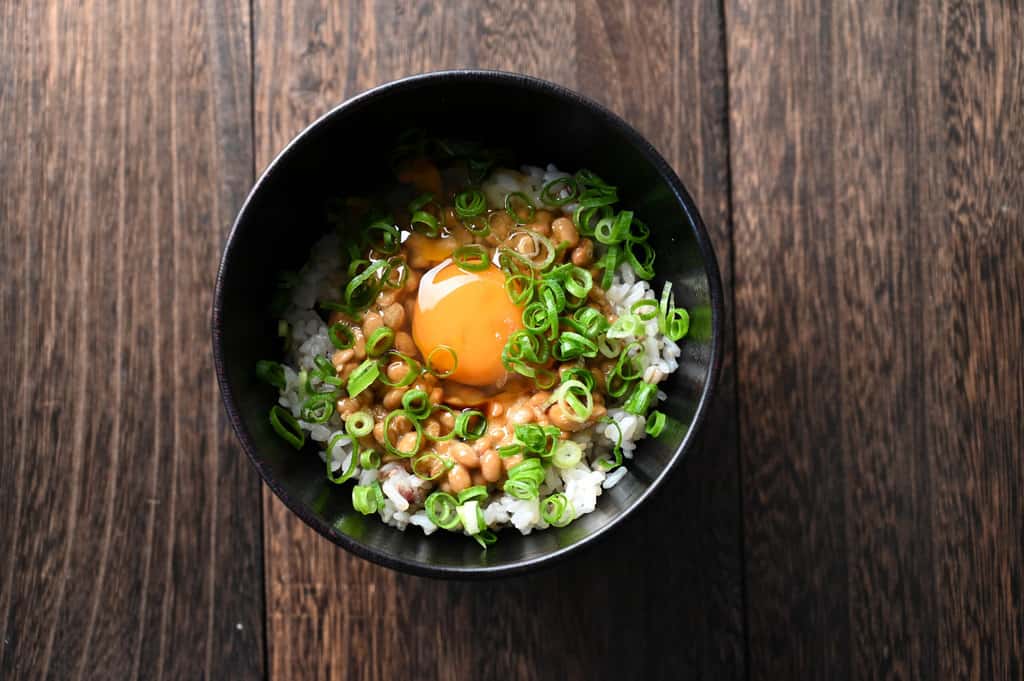
I cannot ignore this most classic combination! Tamago kake gohan and natto. It has always been my favorite combo and always will be. If you haven’t tried natto or are still intimidated by natto, please check my detailed post dedicated to natto!
- Amount: 1 pack of natto, 1 tsp soy sauce topped with 1 tbsp chopped green onion
- Recommended: For a classic combo
- My personal rating: ★★★★★ (5/5)
Tanuki
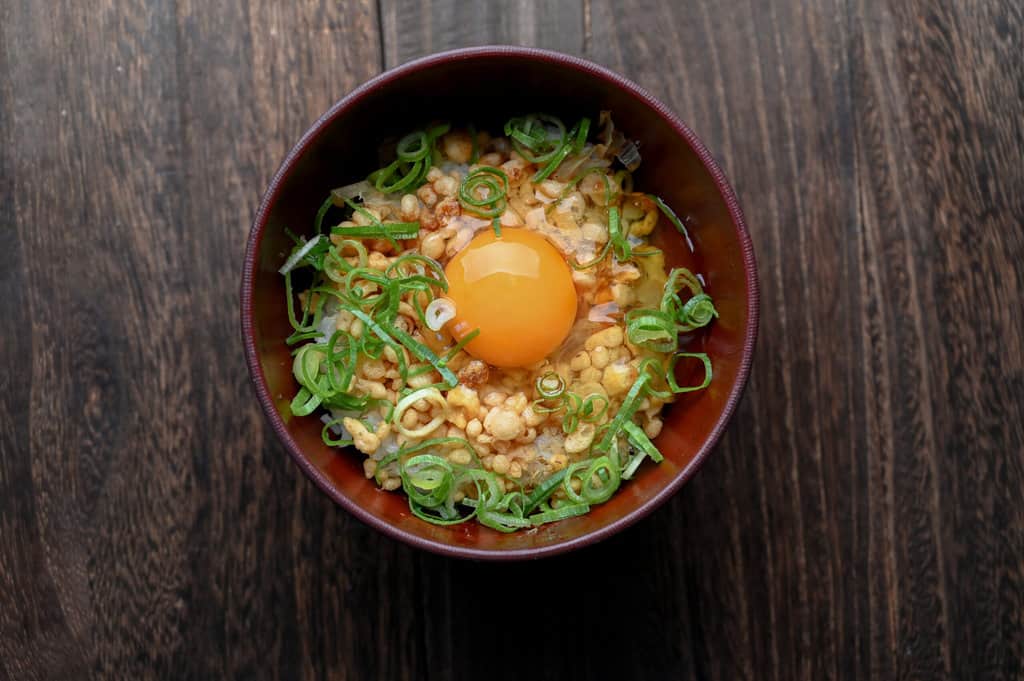
The word tanuki means Japanese raccoon dog, but in a cooking context, it often refers to something with tenkasu (tempura bits), like tanuki udon. This tanuki tamago kake gohan is topped with tenkasu, bonito flakes, and chopped green onion! The ultimate Japanese combo!
- Amount: 1-2 tbsp tenkasu, 1 tbsp chopped green onion and 1 tsp bonito flake
- Recommended: For the ultimate Japanesey tamago kake gohan
- My personal rating: ★★★★★ (5/5)
Avocado Wasabi
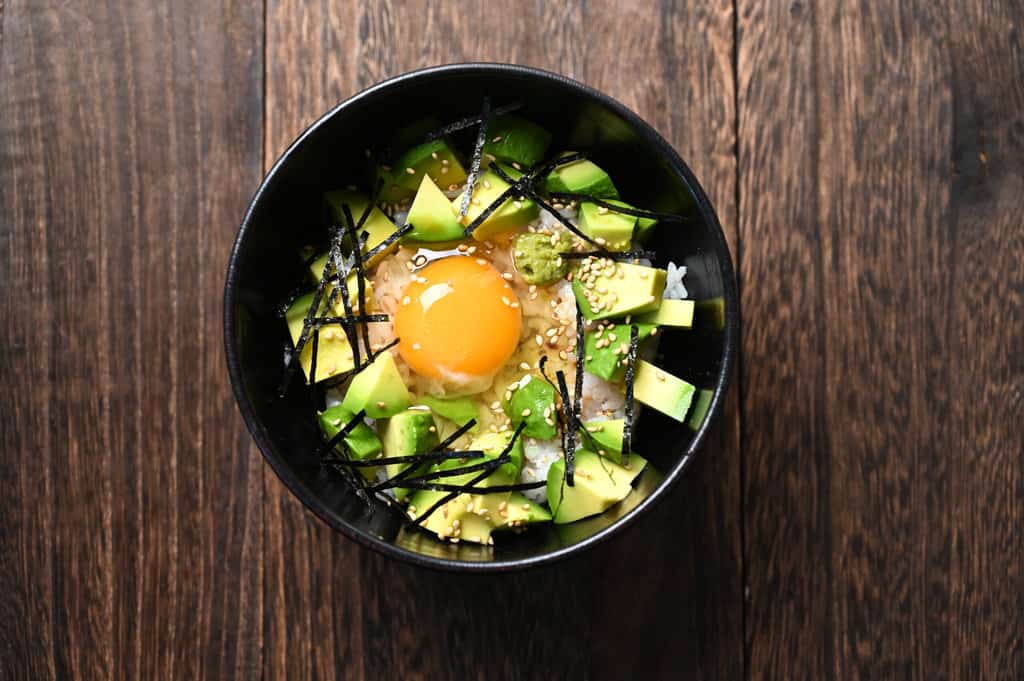
Looking for something veggie with a meaty texture? Then avocado is a good option! On top of it, add a bit of wasabi, which is well-known in Japan for being a good friend of avocado. I also added sesame seeds, kizami nori (thin strips of roasted seaweed), and sesame oil on top! I really liked this one!
- Amount: 1/2 avocado, 1 tsp sesame seeds, 1 tsp sesame oil, 1/2 tsp wasabi paste (For the sauce, I used 1/2 tsp soy sauce and 1/2 tsp tsuyu sauce instead of 1 tsp soy sauce)
- Recommended: For more meaty texture
- My personal rating: ★★★★★ (5/5)
Prosciutto & Parmigiano Reggiano
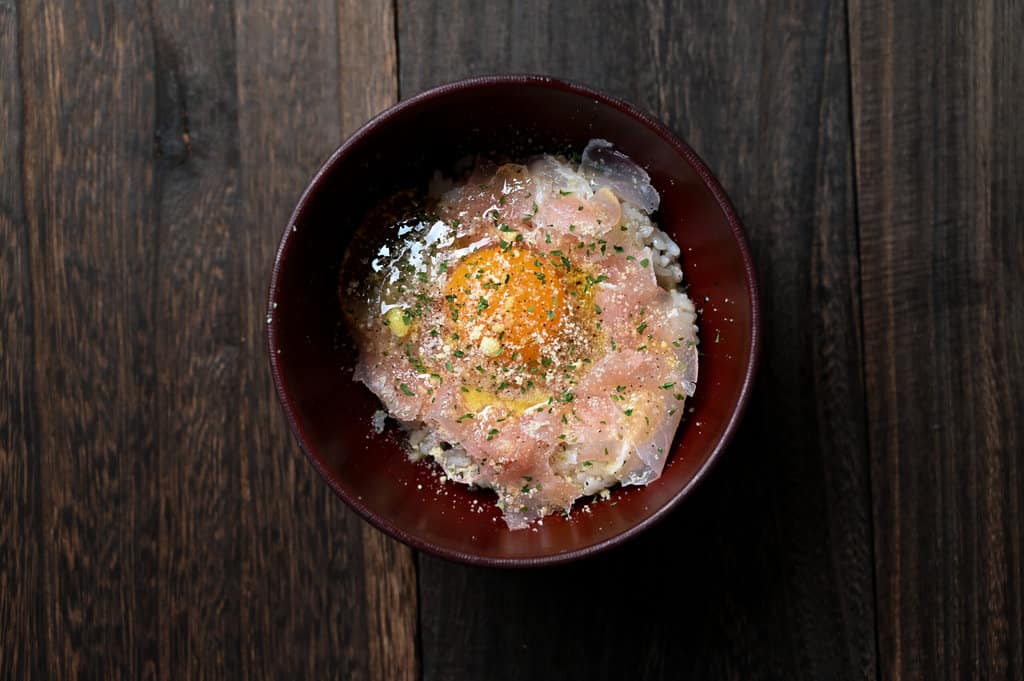
This is a rather quirky combination, but it’s so good! A generous amount of prosciutto, grated Parmigiano cheese topped with olive oil and parsley! With this European-inspired twist, You can experience something completely different from the usual tamago kake gohan!
- Amount: 50g prosciutto, 1/2 tsp grated Parmigiano cheese, 1/2 tsp olive oil, a pinch of dried parsley, a pinch of salt and pepper (instead of soy sauce)
- Recommended: For someone who wants to try something unique
- My personal rating: ★★★★★ (5/5)
Daikon & Shirasu
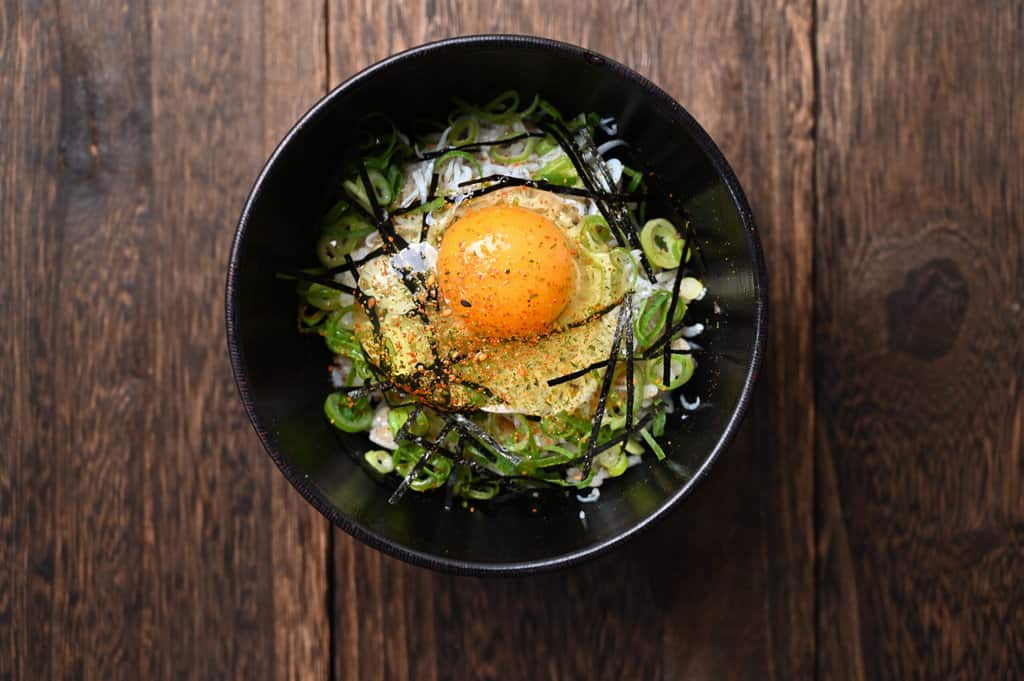
Another extremely Japanesey combo!
- Shirasu (boiled whitebait)
- Grated daikon
- Chopped green onions
- Kizami nori
- Shichimi pepper
- Sesame oil
If you’re looking for a bit sour and fishy tamago kake gohan, this might be the one you want to go for!
- Amount: 1-2 tbsp shirasu, 1-2 tbsp grated daikon, 1 tbsp chopped green onions, 1 tsp kizami nori, 1 tsp sesame oil and a pinch of shichimi pepper
- Recommended: For someone who wants to try something extremely Japanese
- My personal rating: ★★★★★ (5/5)
Okaka
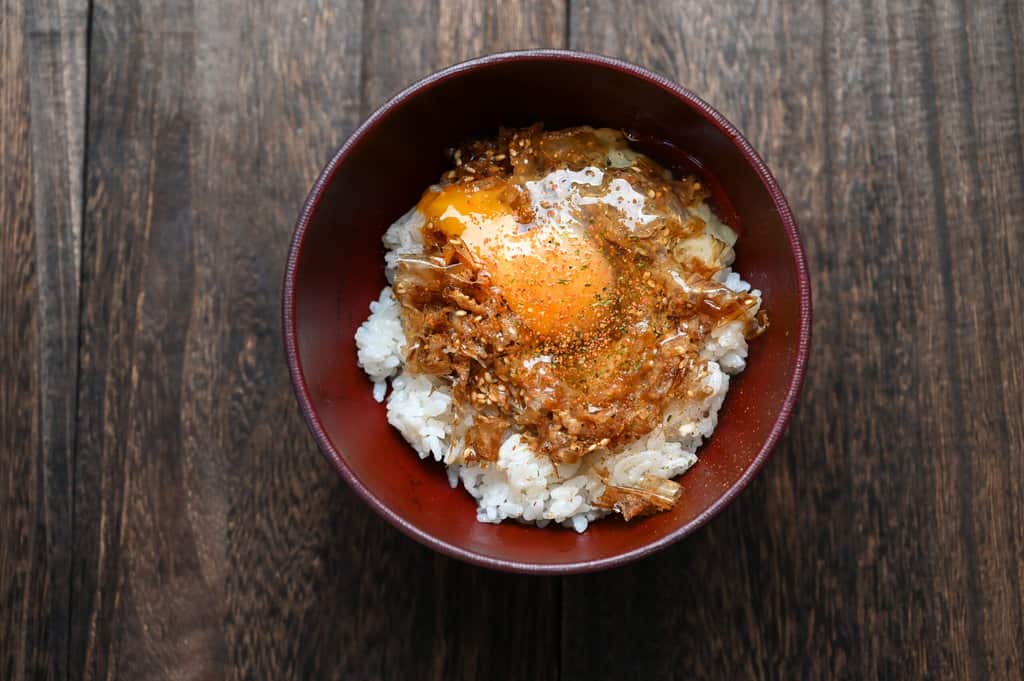
Okaka is basically a way to express bonito flakes, but in modern days, it often refers to flavored bonito flakes. It’s especially popular with rice balls (okaka onigiri), for which you can find my recipe here.
This achieves a classic Japanesey taste and if you happen to like okaka onigiri already, it’s definitely worth a shot! Because okaka is flavored enough, you can omit soy sauce in this one.
- Amount: 5g bonito flakes (katsuobushi), 1 tsp tsuyu sauce, 1 tsp sesame seed (all mixed together) topped with a pinch of shichimi pepper (if you need detailed steps, you can refer to okaka onigiri recipe)
- Recommended: Someone who already likes okaka
- My personal rating: ★★★★★ (5/5)
Spicy
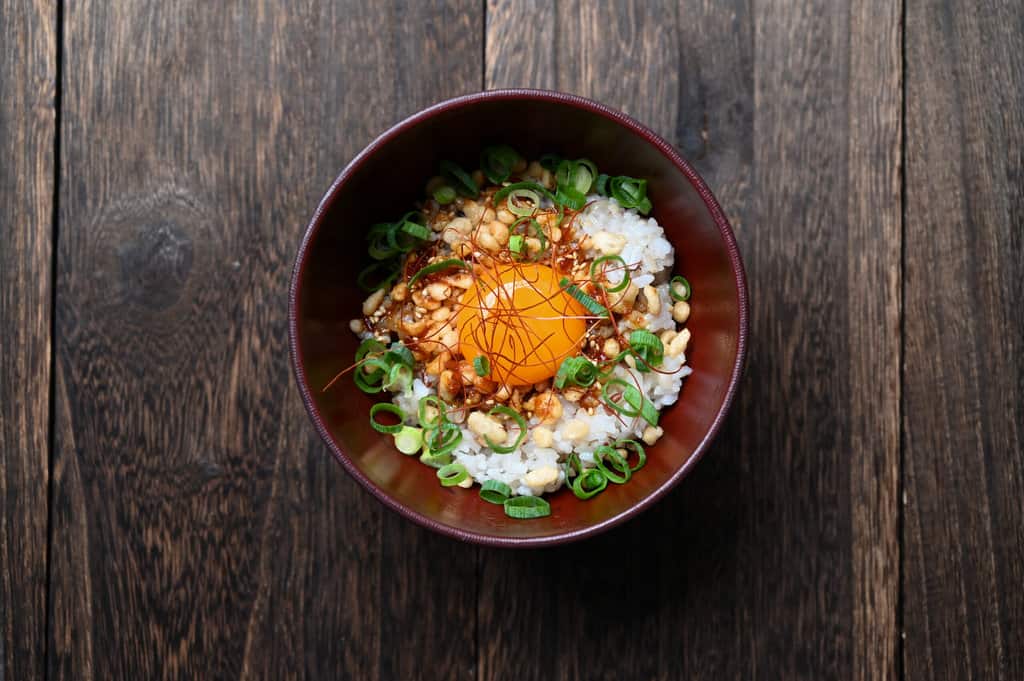
Like your food to be spicy? Then this tobanjan tamago kake gohan might be for you!
- Tobanjan
- Tenkasu
- Chopped green onions
- Sesame oil
- Sesame seed
- Chilli thread
Those combined with an egg are perfect!
- Amount: 1 tsp soy sauce, 1/2 tsp sesame seed, 1 tsp sesame oil, 1/2 tsp tobanjan (all mixed together) topped with 1 tsp chopped green onions and a bit of chili thread
- Recommended: Someone who already likes spicy food
- My personal rating: ★★★★★ (5/5)
Cheese & Butter
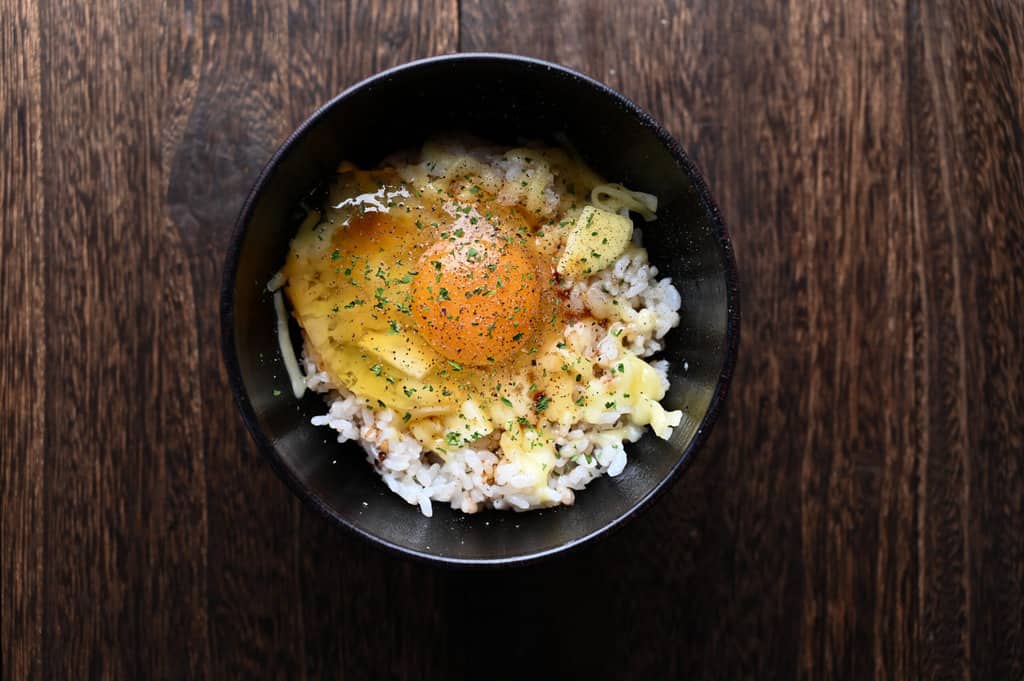
Melty cheese and unsalted butter is a good combo, but does it work with tamago kake gohan? Yes, it does. If you like cheesy flavor, this might be for you. I used shredded gouda cheese and a bit of unsalted butter topped with black pepper and parsley.
Certainly something completely different!
- Amount: 1 tsp unsalted butter, 1 tbsp shredded melty cheese (like gouda), and a pinch of black pepper and parsley
- Recommended: Someone who likes cheesy flavor
- My personal rating: ★★★★☆ (4/5)
Bacon & Parmesano Cheese
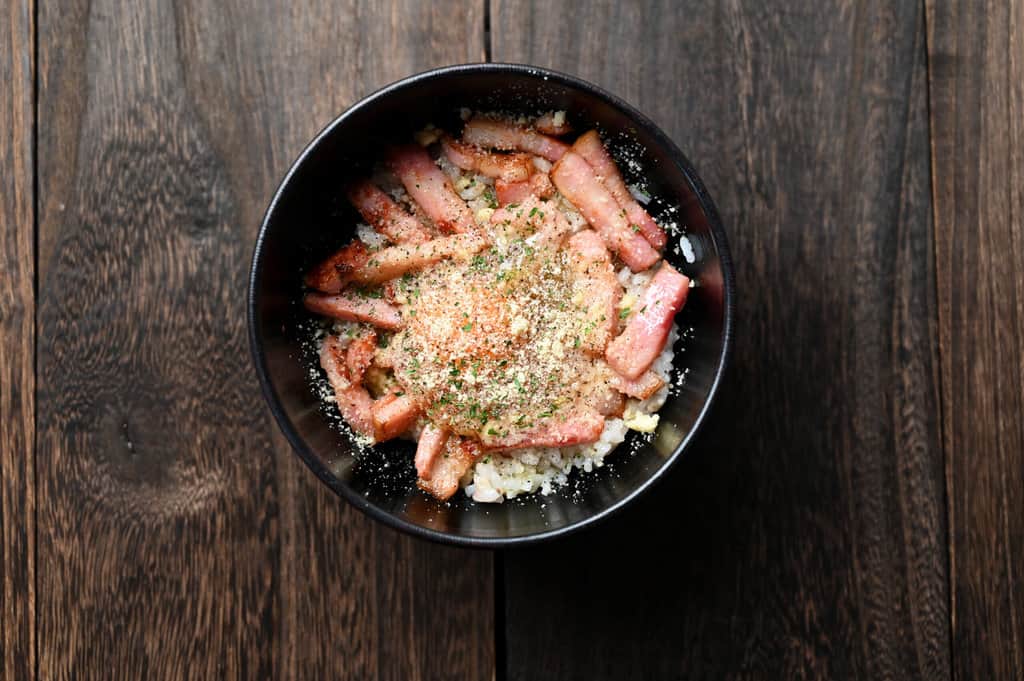
It’s sometimes called “carbonara style tamago kake gohan” as a joke. Of course, it’s a completely different thing, but it contains cooked bacon and hard cheese. I personally prefer the prosciutto one that I mentioned earlier!
- Amount: 30g cooked bacon, 1 tsp parmesan cheese topped with dried parsley
- Recommended: Someone who likes bacon
- My personal rating: ★★★★☆ (4/5)
Taberu Rayu
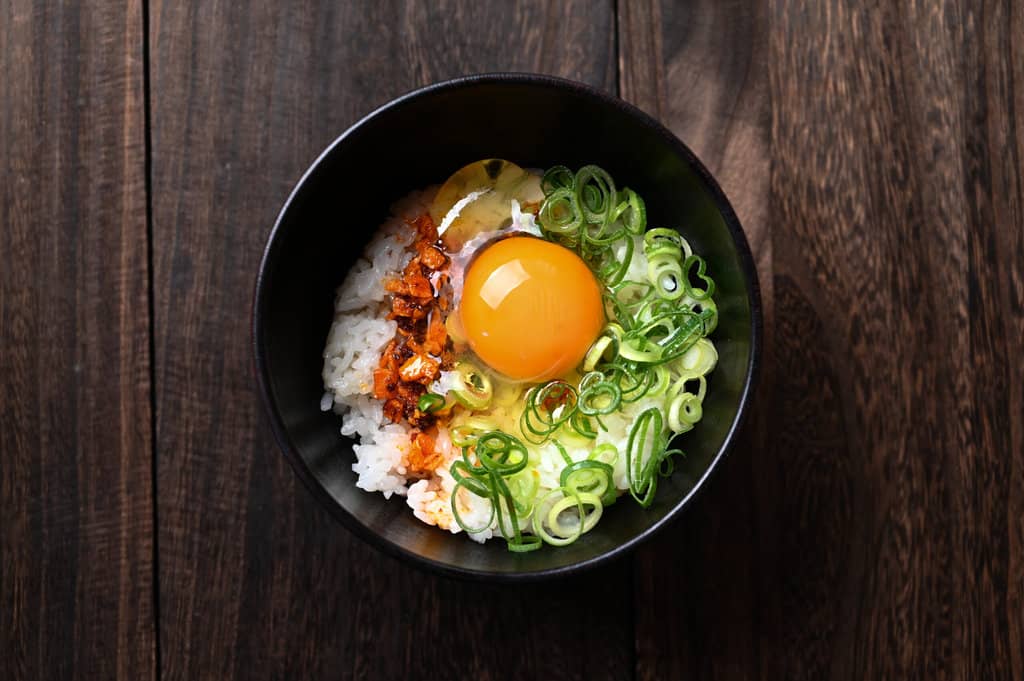
Taberu rayu (食べるラー油) is a popular and modern condiment in Japan. It’s basically chili oil with fried garlic and other stuff like miso. I think it’s a miracle condiment that works with many things. When I was in high school, I was obsessed with it and put taberu rayu on everything! Just add a generous amount and top with chopped green onion.
- Amount: 1-2 tbsp taberu rayu, 1 tbsp chopped green onion
- Recommended: Someone who is looking for something different
- My personal rating: ★★★★☆ (4/5)
Junky
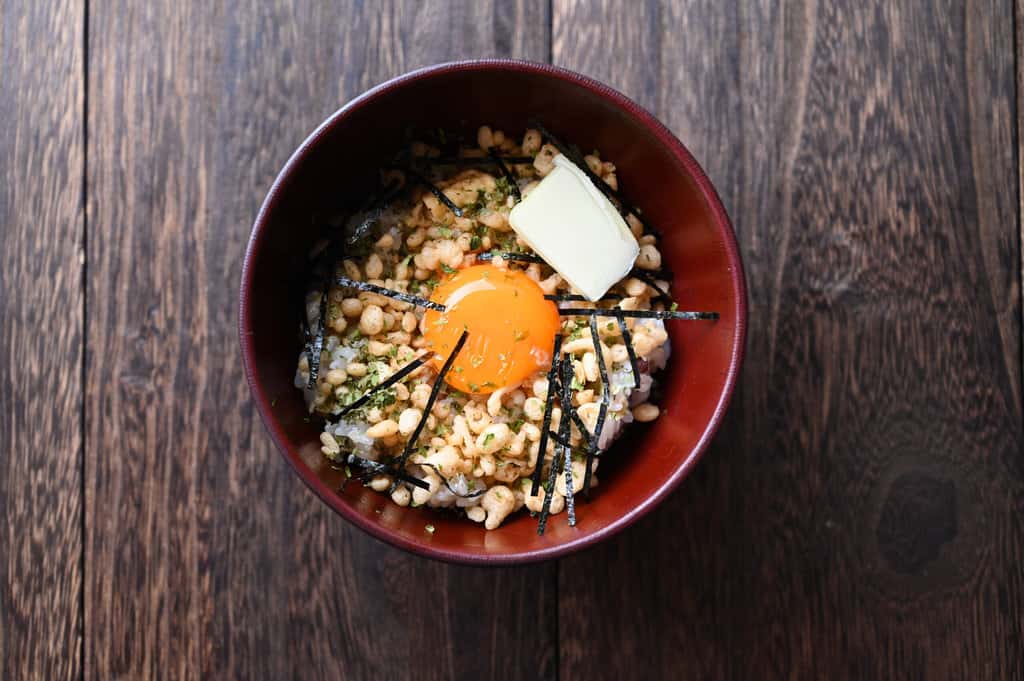
I was feeling like something junky when I made this one so I added naughty stuff like butter, tenkasu and chicken stock powder. Well, what can I say? As you can guess, it’s good and bad at the same time!
- Amount: 1 tsp unsalted butter, 1 tbsp tenkasu, 1 tsp sesame oil, 1 tsp tsuyu sauce, 1/2 tsp aonori, 1 tsp kizami nori, 1/2 Chinese style chicken stock powder
- Recommended: When you want something junky
- My personal rating: ★★★★☆ (4/5)
Yukari
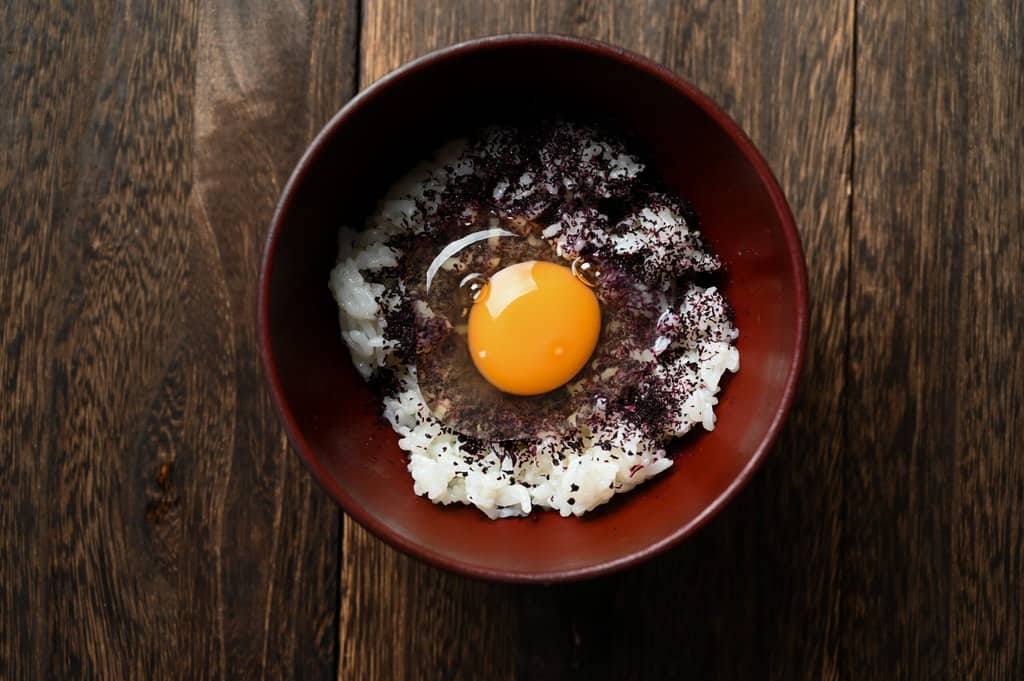
Yukari is a popular furikake in Japan with a distinctive salty (very) and sour flavor of shiso leaves. In this Yukari tamago kake gohan, I use Yukari instead of soy sauce as a salt component. If you like Yukari, it’s definitely worth a try!
You can find my homemade yukari furikake here.
- Amount: 1 tbsp Yukari
- Recommended: Someone who already like Yukari furikake or pickled plum flavor
- My personal rating: ★★★★☆ (4/5)
Meringue
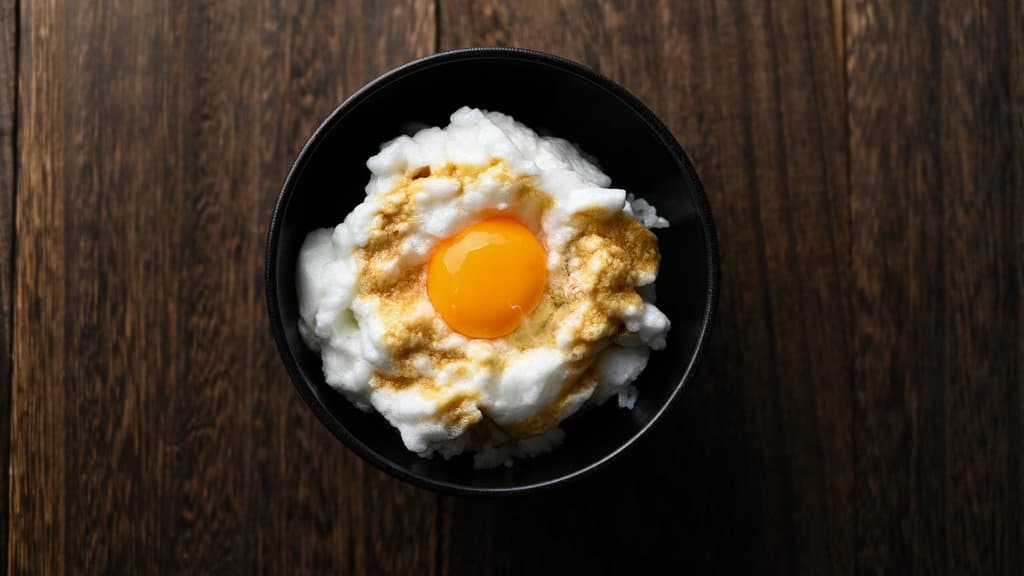
It is a modern way to make tamago kake gohan in Japan at the moment. We basically whisk the egg white to make a foamy meringue, and the rest is the same. It does have a different texture, of course, but personally, I don’t know if it’s worth the effort…
- Amount: 1 egg white, 1 egg yolk, 1 tsp soy sauce
- Recommended: Someone who wants to try a modern twist that is popular in Japan
- My personal rating: ★★★☆☆ (3/5)
Unsalted Butter
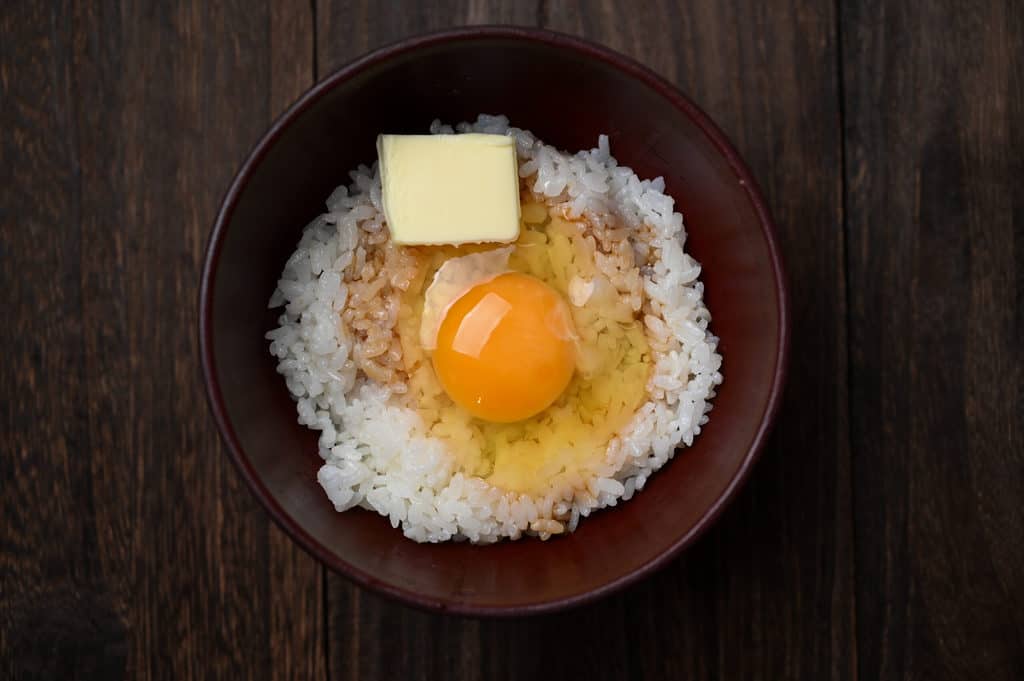
It’s called “naughty” or “devil” tamago kake gohan in Japan. The added fat will kind of sweeten up the tamago kake gohan and definitely enrich the taste. Of course, soy sauce and butter are a golden combo as well!
- Amount: 1 tsp unsalted butter
- Recommended: Someone who wants to add richness
- My personal rating: ★★★☆☆ (3/5)
Sesame Oil & Salt
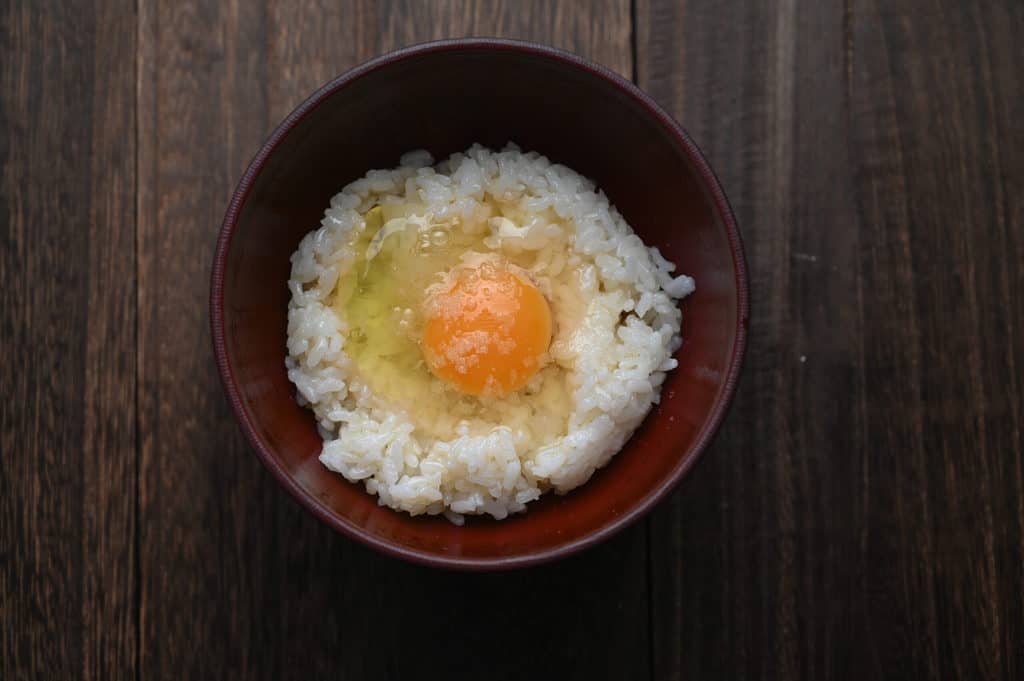
This is a popular topping in Japan. Instead of soy sauce, we use salt and sesame oil instead. I personally think it kind of lacks in punch but surely has a different flavor to general tamago kake gohan!
- Amount: 1/4 tsp salt and 1 tsp sesame oil instead of soy sauce
- Recommended: Someone who would try something different
- My personal rating: ★★★☆☆ (3/5)
FAQ
So, did this simple dish die out? No, if anything, love for Tamago Kake Gohan has become even bigger over time! Young people started to call it TKG, and the dish has so many modern twists. There is even an organization called “Japan Tamago Kake Gohan Research Institute, Inc. (一般社団法人日本たまごかけごはん研究所).”
In modern Japan, eggs are recognized as a food that can be eaten raw.
Eggs in Japan are cleaned with disinfectants such as hypochlorite solution for food disinfection. Other safety measures are taken to prevent the attachment of pathogens, per the Government’s Hygiene Management Guidelines, before they are packed at egg sorting and packaging facilities.
The standards of eggs vary greatly from country to country, so wherever you buy eggs to use for TKG, always check if they’re suitable for raw consumption.
As long as you use pasteurized eggs that are free of pathogens, tamago kake gohan is safe to eat in the US and other countries. Please refer to the information sources available in your country:
USA (FDA)
UK (NHS)
Canada (Government of Canada)
Ireland (FSAI)
Australia (SA Health)
New Zealand (MPI)
Singapore (SFA)
I hope you enjoy this TKG article! If you try it out, I’d really appreciate it if you could spare a moment to let me know what you thought by giving a review and star rating in the comments below. It’s also helpful to share any adjustments you made to the recipe with our other readers. Thank you!
More 101 Articles
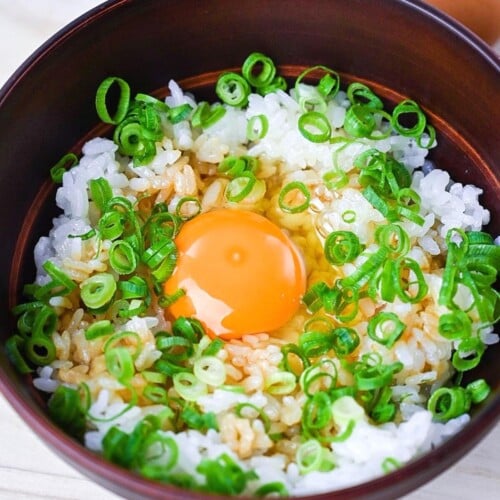
Tamago Kake Gohan (TKG Japanese Egg on Rice)
Ingredients
- 150 g cooked Japanese short-grain rice
- 1 tsp Japanese soy sauce (koikuchi shoyu)
- 1 pasteurized egg
Instructions
- Place 150 g cooked Japanese short-grain rice in a bowl and drizzle with 1 tsp Japanese soy sauce (koikuchi shoyu).

- In a separate bowl, whisk 1 pasteurized egg until the yolk and white is evenly combined.

- Pour the egg over the rice and mix well.

- Add toppings of your choice and enjoy a classic Japanese-style breakfast!

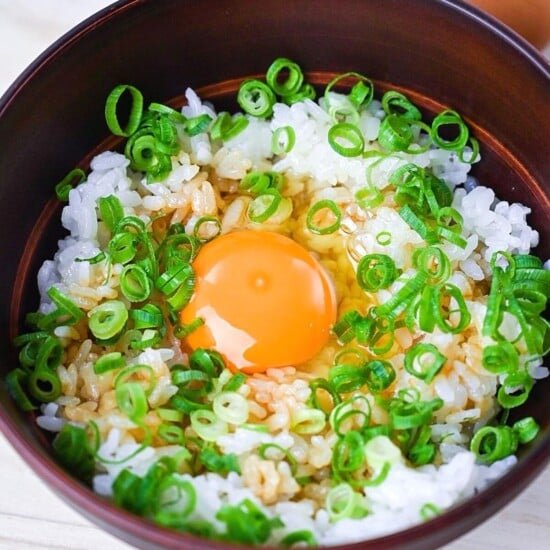


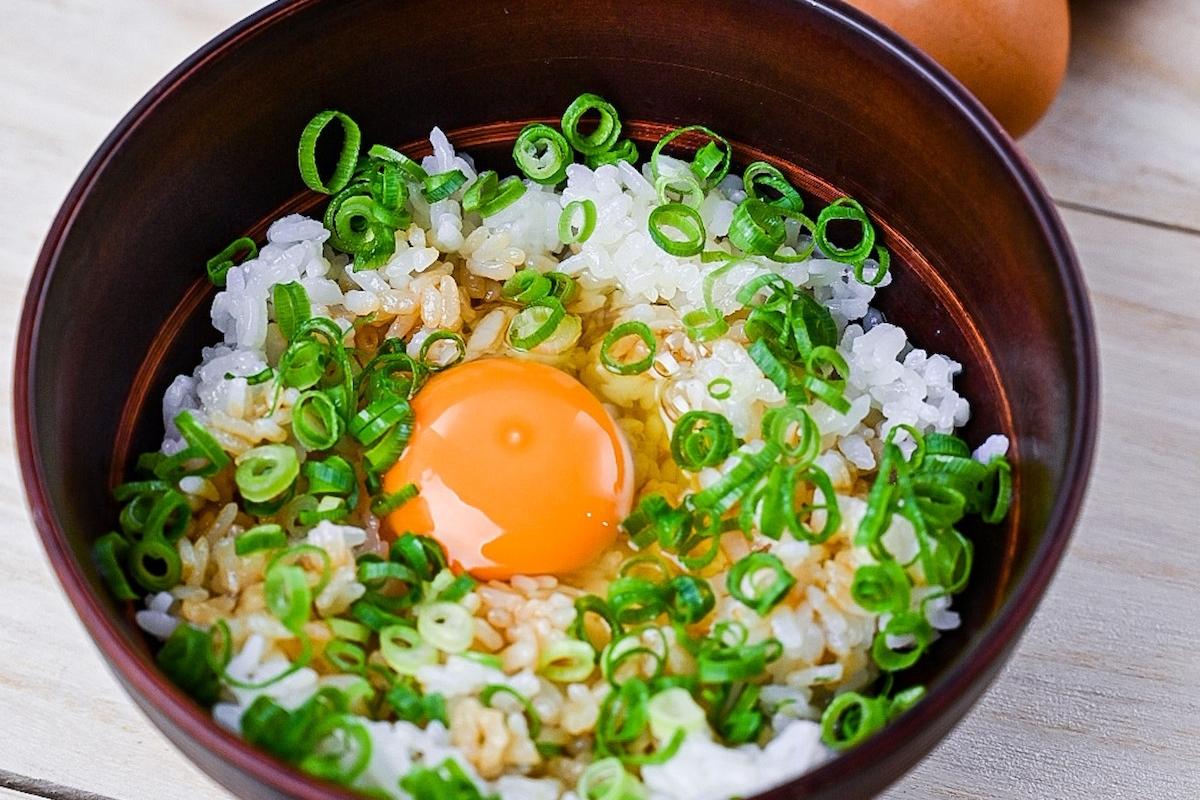
What kind of Japanese soy sauce do you recommend for TKG?
Hi Alex, great question!
I personally use regular koikuchishoyu (the standard dark soy sauce in Japan) but there is actually a special soy sauce especially for TKG which contains kombu and bonito flakes. Essentially, it’s similar to tsuyu sauce but less sweet. I don’t know if it’s easy to buy abroad, but it’s literally called “tamago kake gohan shoyu”. Here it is on Amazon Japan if you want to see what it looks like.
Thank you for your question!
First time trying this I made it with a soft boiled egg..working my way to raw. Is there a reason a raw egg is preferred? More nutrients? Less prep?Thank you for sharing!
Hi Carrie,
Soft-boiled eggs are a good start for sure! In my opinion, I think it’s mainly to do with quick and easy prep in the morning. That said, we do enjoy eating raw eggs with dishes such as sukiyaki (for dipping) etc. and there are also some Japanese people who don’t like eating raw egg too! Maybe your next step could be just the yolk and gradually add more egg white each time. Hope you enjoy!
I grew up eating TKG the way mom prepared it with egg whisked with soy sauce and over rice. As an adult and having my own chickens that lay fresh eggs I learned of a different way to eat it. First separate the yolk and place the egg whites in the bowl with the hot rice. Mix the white and the rice together where it will fluff up a bit giving is like a meringue type feel. Then place the yolk and drizzle the soy or TKG sauce and eat. It definitely has a different taste and feel that I enjoy than any other preparation. When adding other toppings, I put them on the rice and then place the yolk after the additional toppings. Have you heard or tried preparing it this way?
Hi Lica,
Making meringue with the egg whites is a trendy way to make TKG in Japan but I haven’t heard of fluffing it up with the rice. Thank you for the suggestion, I’ll try it next time!
Thanks again!
All the best,
Yuto